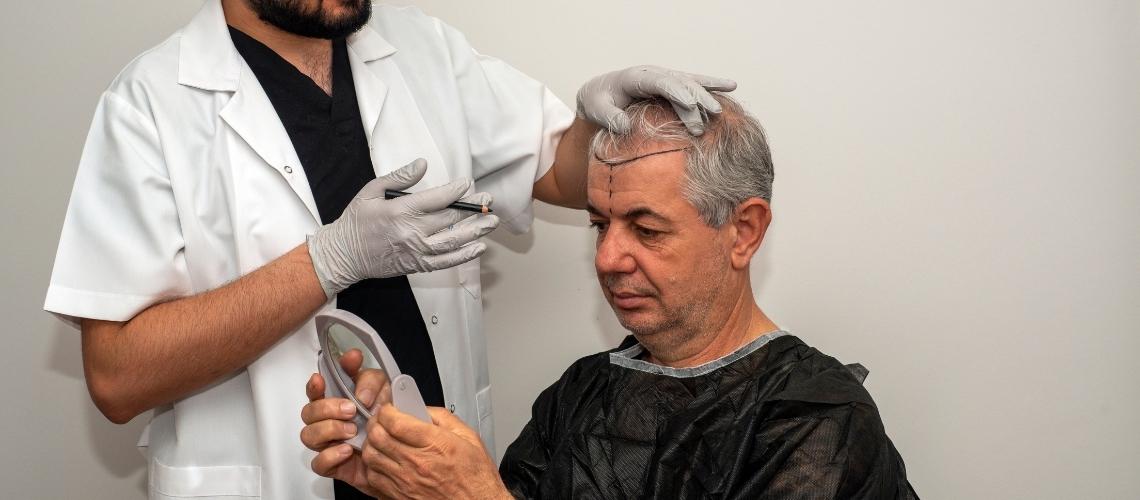
- Hair Transplant
-
by Mehmet Hanifi Kurtlar
Receding hairlines, often caused by male pattern baldness, prompt many to consider hair transplant a lasting solution. This procedure involves moving hair from denser areas to the thinning hairline, offering a potential remedy for those affected by hair loss. Crucially, not everyone is a suitable candidate for this surgery. Factors like age, the extent of hair loss, and the likelihood of further thinning must be evaluated. Consequently, a thorough consultation with a specialist is imperative before proceeding. Such transplants, if successful, can provide long-lasting results, significantly enhancing one’s appearance and self-confidence.
Understanding Hairline Hair Transplant Techniques
Understanding the nuances of hairline hair transplant techniques is essential for those considering this procedure. This sophisticated method involves a meticulous process of transferring hair follicles to the hairline area. The primary goal is to achieve a natural-looking, rejuvenated hairline that counters the effects of a receding hairline.
Key aspects of the technique include:
- Donor Area Selection: The donor area, typically the sides and back of the head, is chosen for its high-density hair. This ensures that the transplanted hair blends seamlessly with the existing hairline.
- Recipient Site Preparation: The hairline and temples, being the recipient sites, are carefully prepared. This involves designing a natural hairline that complements the patient’s facial features.
- Graft Extraction and Placement: Hair grafts are extracted from the donor area. They are then strategically implanted into the recipient site to create a balanced, natural-looking hairline.
The technique’s success hinges on the surgeon’s skill and the patient’s hair characteristics. Factors like hair texture, color, and growth pattern are crucial in the overall outcome. Additionally, post-operative care is crucial for ensuring the longevity of the transplant. Proper care can enhance the results, leading to a more youthful appearance and boosted self-confidence.
Hairline hair transplants offer a transformative solution for those affected by a receding hairline. With advancements in technology and technique, these procedures have become more efficient and effective, providing patients with a lasting solution to hair loss.
Temple Hair Transplant vs. Hairline Lowering
In hair transplant, two distinct methods address hairline concerns: temple hair transplant and hairline lowering. Each caters to different stages and patterns of male pattern baldness, offering tailored solutions for those seeking restoration.
- It primarily targets younger patients, typically between 25 and 35 years old.
- Addresses the initial signs of male pattern baldness, particularly in the temple regions.
- It aims to replenish hair in areas where thinning is just beginning.
- Focused on enhancing the natural hairline without altering its original position.
- Often considered less invasive compared to hairline-lowering surgery.
- Known for yielding a natural-looking result, seamlessly blending with existing hair.
Hairline Lowering Hair Transplant:
- Geared towards individuals experiencing more advanced stages of hair loss.
- Involves lowering the hairline, effectively reducing the forehead’s visible area.
- Suitable for cases where both the hairline and temples have receded significantly.
- Generally, it is more complex and costly than the temple restoration procedure.
- Utilizes donor hair to create a new, lower hairline closer to the eyebrows.
- The goal is typically to achieve a hairline-to-eyebrow distance of around 7.5 cm centrally and 8 cm at the temples.
These procedures, rooted in advanced surgical techniques like follicular unit extraction (FUE), offer transformative results. They address specific hair loss patterns with precision, enhancing the hairline’s appearance and boosting the individual’s confidence. The choice between these methods hinges on the patient’s unique hair loss pattern, age, and desired outcome, underlining the importance of a personalized approach in hair transplant surgery.
An In-depth Look at Follicular Unit Extraction (FUE)
Follicular Unit Extraction (FUE) represents a pivotal advancement in hair transplant technology. Highly favored for its precision and efficacy, this method is a cornerstone in combating hairline recession. Unlike older techniques, FUE meticulously extracts individual hair follicles from denser areas, preparing them for transplantation to the hairline. This ensures a natural-looking result with minimal scarring.
Critical aspects of the FUE process include:
- Extraction of Donor Hairs: Each follicle is carefully selected and extracted, ensuring only the healthiest and most suitable hairs are used.
- Preparation for Transplantation: Once extracted, these grafts are meticulously prepared under high magnification, preserving their viability.
- Recipient Site Preparation: The surgeon creates tiny incisions at the hairline, strategically placing them to mimic natural hair growth patterns.
The FUE procedure typically involves the following:
- Local Anesthesia Administration: Ensures a pain-free experience while the patient remains conscious.
- Extraction Phase: This initial stage takes about 2-3 hours, focusing on harvesting viable hair follicles.
- Grafting Phase: Involves implanting the extracted hairs into the prepared incisions, a process that requires precision and artistry.
Advantages of FUE include:
- Reduced Scarring: Unlike strip harvesting, FUE leaves minimal scarring, allowing for shorter hairstyles post-surgery.
- High Graft Survival Rate: FUE boasts a success rate of 90-95%, offering long-term solutions to hair loss.
- Natural Appearance: The meticulous placement of grafts ensures a natural and dense-looking hairline.
Furthermore, FUE is complemented by post-surgery treatments like finasteride, enhancing the longevity and quality of the transplant. This combination of surgical precision and ongoing care positions FUE as a leading choice for those seeking to address a receding hairline. The technique’s ability to deliver consistent and aesthetically pleasing results marks it as a preferred option in hair restoration.

